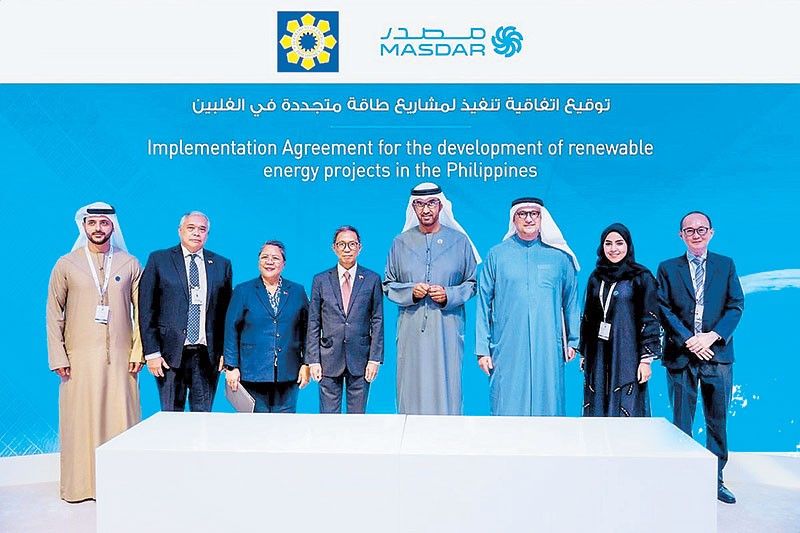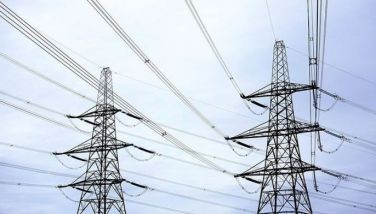UAE firm commits $15 billion investment in RE sector

MANILA, Philippines — Emirati state-owned firm Masdar is entering the Philippine renewable energy (RE) market with a committed investment of $15 billion (about P878 billion) to develop green projects across the country.
The Department of Energy (DOE) and Masdar signed an implementation agreement on Wednesday, which operationalizes the memorandum of understanding on energy transition cooperation signed by the Philippines and the United Arab Emirates (UAE) in November 2024.
The signing was led by DOE Undersecretary Rowena Cristina Guevara and Masdar CEO Mohamed Jameel Al Ramahi and was witnessed by DOE Secretary Raphael Lotilla and Sultan Al Jaber, Masdar chairman and UAE Minister of Industry and Advanced Technology.
Under the agreement, Masdar will develop one gigawatt of solar, wind and battery energy storage system projects across the Philippines by 2030, with plans to scale up to 10 GW within a decade.
For its part, the DOE will provide support to Masdar in conducting pre-development activities, technical studies, securing the necessary rights, gathering project details and obtaining all required permits and approvals.
It will likewise facilitate Masdar’s applications for investment incentives and tax exemptions, with the latter leading the project development and supervising commercial, technical, financial and environmental work streams.
“Building on the longstanding ties between the Philippines and the UAE and the recent energy transition cooperation, this partnership with Masdar marks a transformative step in our renewable energy journey,” Lotilla said.
This landmark deal, the secretary claimed, would set a “new benchmark” in the region’s energy transition push.
“Under President Marcos Jr.’s leadership, the Philippines is integrating renewable energy into its energy mix on an unprecedented scale, ensuring energy security while fostering sustainable economic growth and environmental stewardship,” Lotilla said.
The Philippine Energy Plan outlines the target of expanding the share of renewables in the country’s power generation mix to 35 percent by 2030 and 50 percent by 2040.
Currently, renewables account for only about 22 percent of the Philippine energy mix.
“By leveraging the UAE’s world-class expertise in renewable energy and the Philippines’ abundant natural resources, this agreement will create jobs, drive low-carbon socio-economic progress and expand global renewable energy capacity in line with the UAE consensus,” Al Jaber said.
This partnership marks Masdar’s first-ever investment in the Philippine RE sector, fueling its aggressive expansion in Southeast Asia and reinforcing its ongoing efforts to achieve an RE capacity of 100 GW by 2030.
“With our proven success in implementing large-scale renewable energy projects in the region and worldwide, we look forward to utilizing our expertise and experience to support the Philippines in meeting its ambitious energy goals,” Al Ramahi said.
Market analysts interviewed by The STAR believe that Masdar’s investment will not only fast-track the rollout of RE projects in the Philippines but also help bring down power costs.
“We fully support the continuing initiative of the DOE and the national government in inviting foreign investors to enter the renewable energy market in the Philippines,” said Jose Layug Jr., president of Developers of Renewable Energy Advancement Inc.
“As we are all aware, the electric power industry is a capital-intensive business that requires companies with deep pockets. Masdar can certainly provide the necessary funding to build the one GW of new RE projects,” Layug said.
Juan Paolo Colet of China Bank Capital Corp., meanwhile, said Masdar’s entry “signals high confidence” in the country’s economic prospects and clean energy targets.
“They are a well-known name in the global renewable energy industry, so having them here boosts the profile of the Philippines as an investment destination,” Colet said.
“Their aim to scale up to 10 GW will be a massive boost to domestic clean energy supply and has the potential to lower electricity costs,” he added.
- Latest
- Trending
































